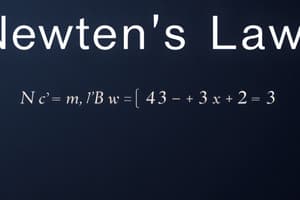Podcast
Questions and Answers
What is the force that arises between two surfaces in contact?
What is the force that arises between two surfaces in contact?
- Electromagnetic force
- Gravitational force
- Normal force
- Frictional force (correct)
What happens when the pushing force is greater than the friction force?
What happens when the pushing force is greater than the friction force?
- The object starts moving (correct)
- The object moves in the opposite direction
- The object does not move
- The object moves with a uniform velocity
What is required to accelerate the motion of an object?
What is required to accelerate the motion of an object?
- An unbalanced force (correct)
- A balanced force
- A gravitational force
- A normal force
What happens when we stop pedalling a bicycle?
What happens when we stop pedalling a bicycle?
What is the result when the forces acting on an object are balanced?
What is the result when the forces acting on an object are balanced?
What is the direction of the friction force when we push a box?
What is the direction of the friction force when we push a box?
What happens to the motion of an object when an unbalanced force is applied?
What happens to the motion of an object when an unbalanced force is applied?
Why does the box not move when we push it with a small force?
Why does the box not move when we push it with a small force?
What is the 'natural state' of an object, according to the beliefs held before Galileo and Newton?
What is the 'natural state' of an object, according to the beliefs held before Galileo and Newton?
What is the primary way we experience the concept of force in our daily lives?
What is the primary way we experience the concept of force in our daily lives?
Which of the following is NOT a way in which a force can affect an object?
Which of the following is NOT a way in which a force can affect an object?
Why does a ball on the ground, when given a small hit, not move forever?
Why does a ball on the ground, when given a small hit, not move forever?
What was the primary contribution of Galileo and Newton to our understanding of motion?
What was the primary contribution of Galileo and Newton to our understanding of motion?
What is the key difference between uniform and non-uniform motion?
What is the key difference between uniform and non-uniform motion?
How can a force be used to change the magnitude of an object's velocity?
How can a force be used to change the magnitude of an object's velocity?
Which of the following examples best illustrates the concept of force changing the shape and size of an object?
Which of the following examples best illustrates the concept of force changing the shape and size of an object?
Flashcards are hidden until you start studying
Study Notes
Motion and Causes
- Motion of an object is described through position, velocity, and acceleration.
- Two types of motion exist: uniform (constant speed) and non-uniform (changing speed).
- Questions arise about the cause of motion: Why does speed change? Does motion require a cause?
- Historically, the belief was that rest is the natural state of objects, challenged by Galileo and Newton.
Introduction of Force
- Everyday experiences show that effort (push, hit, pull) is needed to change an object’s state of motion.
- The concept of force emerges from the need to apply energy to initiate or alter motion.
- Although force cannot be directly observed, its effects can be experienced through changes in motion.
Effects of Force
- Forces can increase or decrease an object's velocity and change its direction of motion.
- Forces can alter the shape and size of objects, as demonstrated with springs and rubber balls.
Friction and Motion
- Friction opposes motion; it arises between two surfaces in contact and can prevent an object from moving.
- An example shows a box that does not move when pushed against friction until the applied force exceeds the frictional force.
- Increased effort can lead to movement only when the pushing force surpasses friction.
Bicycle Motion Example
- When pedaling a bicycle stops, it slows down due to friction acting against its movement.
- Continuous application of an unbalanced force is needed to maintain motion.
- Correctly, an object moves with uniform velocity only when forces acting upon it are balanced; change requires an unbalanced force.
Summary of Forces
- An unbalanced force is essential for accelerating an object, leading to changes in speed or direction.
- The effect of this force persists as long as it is applied, demonstrating the principle of dynamics in motion.
Studying That Suits You
Use AI to generate personalized quizzes and flashcards to suit your learning preferences.




